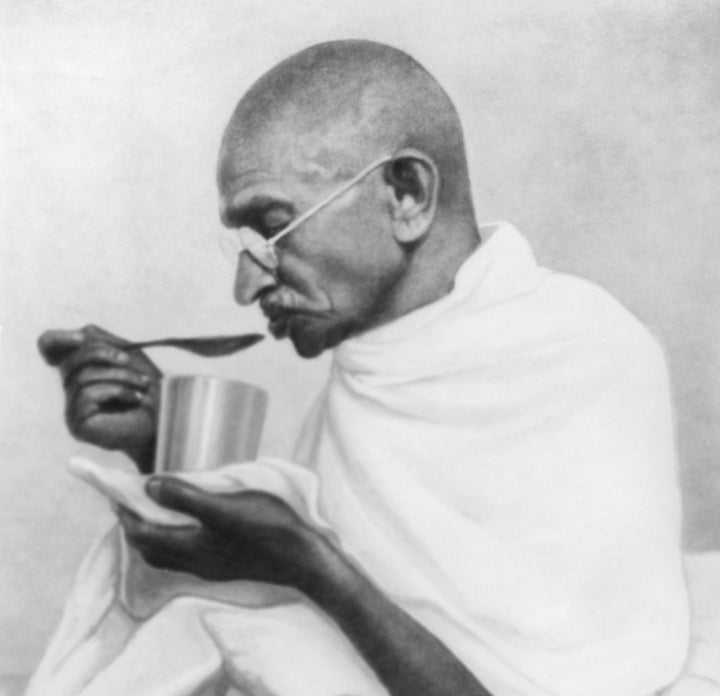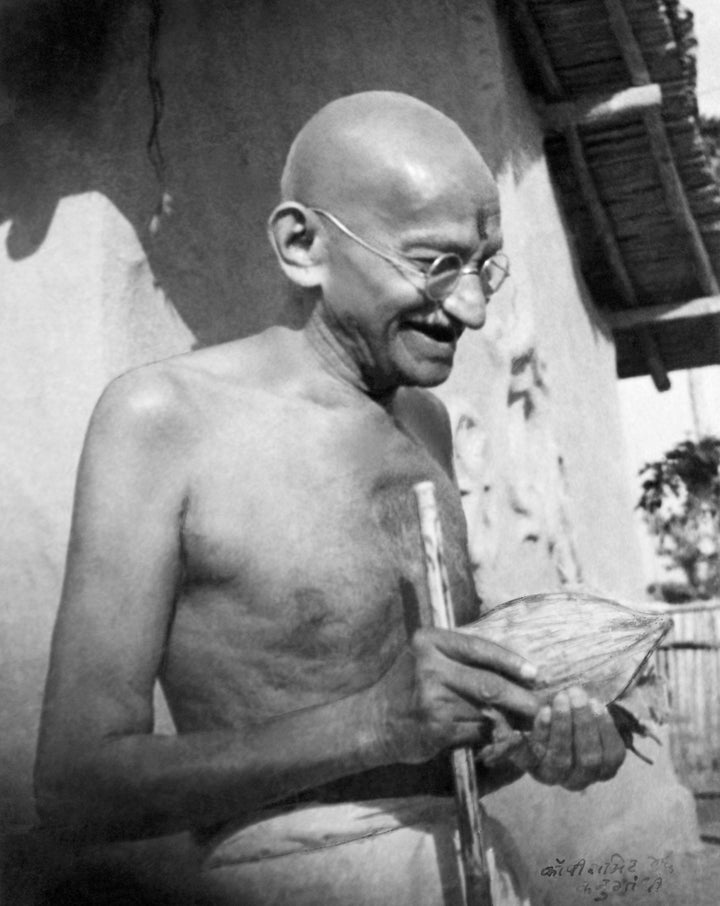Mahatma Gandhi was known as many things: a peacemaker, an activist, a spiritual leader and a hero. The man, born Mohandas K. Gandhi, helped India gain its independence in 1947 and fasted to end widespread violence dozens of times. While society knows him as a role model for peaceful protest, Gandhi also spent his 78 years studying one personal passion: nutrition.
Some of Gandhi’s diet choices were protest-based, such as fasting for days on end. Others tied back to his dedication to nutrition, including his distrust of processed foods.
According to Nico Slate, author of the new book “Gandhi’s Search for a Perfect Diet,” healthy eating was always part of Gandhi’s life.
“Gandhi’s interest in healthy eating started during childhood; his mother was a religious observer who fasted often and was careful about the foods she ate and served,” Slate told HuffPost. “He was a curious man, and like many parts of life, he had the desire to think deeply about his food.”
While Gandhi died over 70 years ago, his diet was well ahead of its time. Virtually all elements of Gandhi’s diets ― which raised eyebrows among his peers ― are commonplace, or even “fad diets,” today. Slate, who spent five years researching Gandhi’s history with nutrition, noticed a number of core themes.

Gandhi was skeptical of salt, then drastically changed his views
While Gandhi knew his favorite fruits and vegetables naturally contain salt, he steadfastly avoided adding any additional salt to his meals. According to Slate, Gandhi embarked on a salt-free diet in 1911, but he eased up over time after listening to his doctors. By the late 1920s, Gandhi welcomed a little salt ― no more than 30 grains per day ― into his diet.
California-based dietitian nutritionist Ashley Lytwyn agrees with Gandhi’s doctors.
“Salt is one of the electrolytes we absolutely need to function,” she told HuffPost. “We have a fear of salt in our culture, but if you’re eating a balanced diet, your body is naturally going to consume the adequate amount of salt.”
After understanding the importance of salt ― particularly for those working in the fields ― Gandhi went on to protest Britain’s hefty tax that made salt virtually unattainable for poor people in India. His 60,000-protester-strong Salt March in 1930 was integral to India gaining independence in 1947.
Veganism was too restrictive, so Gandhi gave up meat
Gandhi was born into a vegetarian household, but he always aspired to be vegan. He tried veganism as a young adult but, after suffering severe health issues, he was forced to change course.
“Experience has taught me that in order to keep perfectly fit, [a] vegetarian diet must include milk and milk product such as curds, butter, ghee, etc.,” Gandhi wrote in his book, “The Moral Basis of Vegetarianism.” “I excluded milk from my diet for six years. … But in the year 1917, as a result of my own ignorance, I was laid down with severe dysentery. I was reduced to a skeleton, but I stubbornly refused to take milk or buttermilk. … I could have had in mind only the milk of the cow and buffalo; why should the vow prevent me from taking goat’s milk?”
According to Lytwyn, highly restrictive diets such as veganism can be done, but they require vitamin supplements and nutritional planning.
“Nutrients like B12 can be tough to get with a vegan diet, and the iron in vegetables isn’t as bioavailable as iron in animal proteins,” Lytwyn said. “Even if he ate enough iron-rich vegetables, the body can’t always absorb what it needs.”

After he acc the need for goat dairy in his diet, Gandhi lived as a steadfast ― and healthy ― vegetarian. In fact, vegetarianism actually led to Gandhi’s true calling as a social activist.
“During law school, Gandhi had a transformative experience living with progressive vegetarians in London,” Slate said. “At first, he was terribly shy and not politically active, but these vegetarians had strong beliefs against imperialism and racism; they gave Gandhi the confidence to become an activist, speaker and writer.”
Gandhi was a label-checker who loved raw, unprocessed foods
Like many health-conscious Americans, Gandhi avoided foods with ingredients he couldn’t pronounce. When companies began importing vegetarian alternatives to India’s popular ghee (clarified butter) in the 1930s, many thought he’d accept them without question. Gandhi quickly proved them wrong.
“Since ghee alternatives were made in a factory, Gandhi came out strongly against them,” Slate said. “He wanted simple foods with simple ingredients. If you gave him one of today’s vegan protein bars with 25 obscure ingredients, he wouldn’t eat it.”
Yet again, Gandhi’s diet was ahead of its time; the high trans-fat Vanaspati ghee is notoriously unhealthy. Gandhi expressed concern in his book “Diet and Diet Reform”: “In reality ghee is pure animal product. One thoughtlessly uses the expression vegetable ghee or Vanaspati, but it is a contradiction in terms. Vanaspati as an article of diet is a very poor substitute for ghee. It not only lacks absorption by the human system, but has no vitamin potency.”
Lytwyn fully agrees with Gandhi’s simplistic approach to food but notes that times have changed, and so have our eating schedules.
“Some foods are best served simply,” she said. “Take oatmeal. It’s a beautiful complex carb that tastes delicious ― why alter it? At the same time, people need alternatives in today’s fast-paced culture. If it’s between skipping a meal or eating a granola bar, I’d say eat the granola bar. You need to nourish yourself.”
Fasts were key to Gandhi’s political and nutritional diet
While Gandhi’s fasts altered the course of history ― including his famous 1948 “fast unto death” for peace in Delhi ― he also fasted for religious and nutritional reasons. Gandhi fasted dozens and dozens of times, including his longest stretch of 21 days.
As a specialist in eating disorders, Lytwyn urges dieters to rethink today’s newfound fasting craze, particularly given its focus on weight loss, not activism.
“Gandhi’s nonviolent approach was moving and impactful,” she said. “But, as I’ve seen with many clients, fasting can cause those predisposed to eating disorders to spiral out of control. If you’re excessively restricting yourself, of course your body will overcompensate with a fast-then-binge cycle.”

Gandhi avoided sugar, but couldn’t give up this one “sweet”
For the most part, Gandhi kept sugar out of his diet, but he had one major exception: fruit. He loved fruit. In fact, while he was successfully restrictive when it came to processed or refined sugars, the strong-willed Gandhi had trouble curbing cravings when it came to “sweets” like mango.
“Gandhi tried hard not to eat too much of anything; he thought enjoying food too much would distract him from his spiritual goals,” Slate said. “But Gandhi was human. One time he received this crate of fresh mangoes as medicine for a group of patients he was helping and he just entirely gave in.”
Gandhi, known for restraint against cravings, ate several mangoes before sharing them with his patients. He lamented his overindulgence in a letter.
“Mango is a cursed fruit,” Gandhi wrote in 1941. “It attracts attention as no other fruit does. We must get used to not treating it with so much affection … but they [the patients] will all get some as we have three boxes.”
While Gandhi did give in to cravings, he didn’t respond by throwing away his diet. He acknowledged it, lamented it and moved on. Lytwyn urges her clients to do the same.
“When my clients have an overeating episode, I tell them to learn from it and let it go,” she said. “We don’t have to hold onto this one experience as a moral judgment of ourselves. There’s really no perfect way to eat, and trying to achieve perfection will drive us mad. It’s all about moderation.”
Food is different for everyone, and Gandhi accepted that
According to Slate, Gandhi didn’t push his strict diet and nutritional beliefs on peers. He wrote about his food experiments in letters and books, but humbly acknowledged that he didn’t know everything and openly listened to others’ findings.
While not directly related to his diet, Lytwyn believes this is Gandhi’s greatest food lesson of all.
“We have this cultural obsession where people project their diet and fitness onto others, but if you look at different cultures, they’re not on this never-ending quest for thinness,” she said. “If you gave five different people the same foods and the same exercise plan, they still won’t have the same body at the end of it. We need to embrace our bodies as they are, rather than changing or altering them to the ideals and pressures others project on us.”